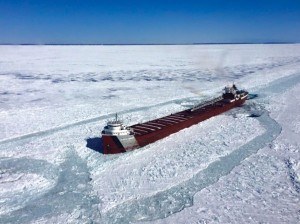Moving slowly: vessel makes its way to port through the ice
by Peter Jakey–Managing Editor
It has been a long journey home for the crew of the Arthur M. Anderson. Earlier this week, the Anderson again was slowed by thick ice – this time near the Mackinac Bridge.
The boat is on its way to Sturgeon Bay, Wisconsin for winter layup, but is having a tough time getting there. Monday afternoon, the Anderson was just east of White Shoal, west of Mighty Mac.
The USCGC Mobile Bay was on scene plowing a path, all the while the Coast Guard had a helicopter in the air looking for a path in the ice. Midday Tuesday, the Anderson was north of Beaver Island and through some of the worst ice with an estimated time of arrival at Sturgeon Bay of noon Wednesday.
“The ice conditions are very challenging,” said Randy Elliot vessel, traffic service watchstander at Sault Ste. Marie

Unfortunately for the crew, that includes nine sailors from Presque Isle County, the only U.S. Coast Guard cutter able to handle this kind of ice within the Great Lakes is the Mackinaw and it is undergoing scheduled maintenance procedures until Monday.
“(Monday) morning, they attempted to take them across the Straits and made very little progress,” said Elliot. The Anderson encountered 100-percent ice coverage with thickness of 24 to 48 inches…That’s ice that has been broken up and it piles up and freezes.”
Early last week, the Anderson made an unexpected stop on its way to pick up a load of iron ore fines in Conneaut, Ohio. It was being escorted by the cutter Bristol Bay, but as the ship approached the southern shore of Lake Erie, the crew encountered thick ice and halted the trip. It was turned around and docked in Detroit before continuing on.
Mark Thompson is a retired sailor and feels for the crew. “The smaller cutters only cut a path that is 30 feet wide and you have a boat that is 70 feet wide,” said Thompson. “For the crew members, it must be a mind-boggling experience to be out there this late in the season.”
Thompson, who sailed for 15 years, said there was a time in the 1970s when the shippi
“This is when you would normally be getting ready for fit-out to start the 2015 season,” added Thompson. An article in the Advance 10 years ago, chronicled the departure of the Cason J. Callaway on the first journey of the season.
“This is a very unusual situation that has to be terribly frustrating for the crew,” said Thompson. “It’s not much of a safety issue…they are designed to handle it.”
